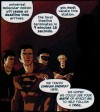On Wednesday, comics writer Ed Brubaker tweeted:
Seriously, anyone not picking up Casanova and Scarlet this week doesn’t want good comics.
Neither of these books had really been on my radar, but since I’ve developed a great deal of respect for Brubaker’s writing over the past year, his recommendation was enough to make me give them a try. So what did I think? Read on…
- Batman and Robin #13, by Grant Morrison & Frazer Irving (DC)
- Brightest Day #5, by Geoff Johns, Peter J. Tomasi, Ivan Reis, Ardian J. Syaf, Joe Prada & Vicente Cifuentes (DC)
- Secret Six #23, by John Ostrander, R.B. Silva & Alexandre Palamaro (DC)
- Tom Strong and the Robots of Doom #2 of 6, by Peter Hogan, Chris Sprouse & Karl Story (DC/Wildstorm)
- Casanova #1, by Matt Fraction, Gabriel Bá & Fábio Moon (Marvel/Icon)
- Fantastic Four Annual #32, by Joe Ahearne, Bryan Hitch & Andrew Currie (Marvel)
- Hercules: Twilight of a God #2 of 4, by Bob Layton & Ron Lim (Marvel)
- Scarlet #1, by Brian Michael Bendis & Alex Maleev (Marvel/Icon)
- Steve Rogers: Super-Soldier #1, by Ed Brubaker & Dale Eaglesham (Marvel)
- Irredeemable #15, by Mark Waid & Diego Barreto (Boom)
- The Boys #44, by Garth Ennis & Russ Braun (Dynamite)
- Hellboy: The Storm #1 of 3, by Mike Mignola & Duncan Fegredo (Dark Horse)

|
The main thing I have to say about this week’s Batman and Robin is: Yaaaggggh! I can’t stand Frazer Irving’s artwork here! I like it even less here than in his issue of The Return of Bruce Wayne. The fake-looking expressions, the stiff coloring job (apparently also by Irving), the images of Dick Grayson and The Joker that barely look like them (how can you draw a Joker that barely looks like The Joker? Irving somehow manages it), the barely-rendered background. Greg Burgas loves his art, but then, this is far from the first time that I’ve been at the opposite end from him.
Like Francis Manapul’s art on The Flash, Irving’s art may soon be a signal to me not to buy a comic. The story’s okay; Morrison brings back Professor Pyg from the first story, which suggests that he’s going to wrap up Dick’s tenure as Batman very soon. He also throws in a teaser about Bruce’s father coming back, having not really been killed, which is nearly impossible to credit, as the guy would have to be around 80 by now (not to mention that it would substantially undercut Batman’s backstory), so obviously there’s something else going on. |

|
Casanova ran as a comic from Image a few years ago, and it seems this series is a reprint of the earlier issues. The premise – as best I can figure it out – is that Casanova Quinn is the son of Cornelius Quinn, the Nick Fury-esque leader of the global spy agency E.M.P.I.R.E. Casanova’s sister, Zephyr, is E.M.P.I.R.E.’s top agent. Casanova, meanwhile, is a thief. The story opens with him on a mission, when Cornelius’ right-hand man, Buck McShane (who resembles Fury’s right-hand man Dum Dum Dugan), shows up to take Casanova down. The reason is that Zephyr has died. This leas to a confrontation between Casanova and his father, followed by an adventure in which Casanova takes down a crime lord in a mental duel, then gets recruited by Newman Zeno, the leader of the global crime organization W.A.S.T.E., ends up in a parallel timeline, and tries to pull off his original heist again.
The story reads a lot like another series Gabriel Bá drew, The Umbrella Academy. It’s the sort of story I file under “madcap nonsensical adventure”. More precisely, the story seems to revel in its being just too darned clever, but doesn’t pay a whole lot of attention to actually making sense. Like Academy, Casanova starts off being intriguing and amusing, but Academy rather quickly devolved into a muddled mess, its storylines pointless and its characters uninteresting (and certainly not sympathetic). So the question is: Will Casanova manage to pull together, gain some focus, and work through some themes and characterizations in depth? Or will it, too, become a muddled mess? That it ostensibly emphasizes a single protagonist gives me hope that it will be the former. But the execution of the first issue makes me worry it will be the latter, and that I’ll stop caring pretty soon. |

|
Brian Michael Bendis’ mainstream comics writing drives me almost as crazy as does J. Michael Straczynski’s. Bendis’ Marvel work, especially his Avengers titles, are little more than a massive dose of navel-gazing continuity clutter, and his affectations in writing dialogue – emphasizing uncertainty and starts and stops while speaking – feel especially out-of-place in Marvel comics, especially titles like The Avengers. On the other hand, Bendis does have one genuine great series to his name, Powers, which is creator-owned, like his new title, Scarlet.
The premise appears to be that the the main character sees the problems and corruption in society and decides to do something about it, sparking a revolution. This issue begins with her and her friends – as young adults – having an unfortunate encounter with a corrupt cop, and the cop kills her boyfriend and injures her. So that’s the spark that sets her off, and from the text page it sounds like the story will get bigger and bigger as it progresses. Scarlet isn’t some superpowered maniac, she’s just a normel person (albeit with some ridiculously big firearms). The first issue is a little annoying in that Scarlet spends most of it talking directly to the reader, and saying we’re going to help her change everything, an affectation that just seems cheesy – a simple first-person testimonial-style narrative would have worked better. But Bendis’ narratives are often full of affectations, so that just comes with the territory I guess. Otherwise the set-up isn’t bad. I’m not particularly blown away, and Scarlet isn’t a very interesting character, yet, but there’s some potential here. Unlike Casanova, which is all over the place, Scarlet stays in one place but doesn’t get very far. But hopefully that will change after another 2 or 3 issues. Alex Maleev’s art reminds me a lot of Tony Harris’, with its ultra-realistic poses and breakdowns, but stylized linework and finishes. The murky coloring job (also by Maleev?) doesn’t bring out the best in the lines, though, rather burying them under fairly bland tones. His figures and expressions are actually less peculiar than Harris’ tend to be (Harris’ faces sometimes feature some rather silly grimaces, while Maleev’s faces look much more genuine), it’s just disappointing that the whole doesn’t live up to the promise of its component parts. So there’s certainly some potential here. I’m hoping Bendis isn’t going to drag out the build-up of the storyline across a year or two, and rather goes for the jugular sooner rather than later. I’m not sure the book will hold my attention if it stays at this level for more than a few issues, unless the characters develop suddenly and dramatically (and, uh, unless we end up with more than one major character). I’ll give it a few issues and see how it shapes up. |

|
Ironically, Ed Brubaker’s comic out this week is better than either of the ones he touted in his tweet. It’s starting to amaze me how much Brubaker is able to plumb the depths of Captain America’s past, yet not seem like he’s going to the well too often. Steve Rogers: Super-Soldier has a stupid title, but the story itself is quite good. Steve Rogers, of course, was the original Captain America, but when he returned from death (or wherever it was he was, I haven’t read Captain America Reborn yet) he let Bucky Barnes keep the title (and the shield). Now Steve’s the leader of the Avengers and “America’s top law-enforcement agent”, which I guess means he’s on a par with the leader of S.H.I.E.L.D. without all the paperwork. Of course, we can’t blame Brubaker for the convoluted backstory (well, mostly not), but you can boil it down to “superhuman government agent who’s just not Captain America anymore”.
But the source of this story is that the grandson of the man who gave Steve his powers has apparently replicated the formula and is putting it on the market to the highest bidder, and Steve breaks into the hotel where the auction is supposed to take place to stop it. But not only have things already started to get out of control, but it turns out something rather different is going on – something Steve will have to figure out in the coming issues. It’s a pretty good set-up, and fits in perfectly with Brubaker’s other Cap stories. I keep thinking Dale Eaglesham’s art ought to be better than it is. His linework varies from nuanced (especially in his use of shadows) to strangely simplistic. His compositions are fine, but occasionally his figures seem stiff and overly posed. This was my impression when I first saw his work in Justice Society of America 3 years ago, but oddly I don’t think he’s advanced a lot on that time. His work here seems influenced by Jim Steranko, which is a good thing (and probably not a coincidence), but it’s still not entirely successful. The worst part of the comic, though, is that awful costume Steve’s been saddled with. It’s like Nick Fury’s S.H.I.E.L.D. outfit fought Captain America’s costume, and both lost. But I can get past that. |

|
Being the fill-in artist for Darick Robertson is going to be a tough job for almost anyone, but the guys who have filled those shoes on The Boys haven’t really come close to reaching Robertson’s skills. To my surprise, though, not only for Russ Braun do a creditable job this week, but his style is so close to Robertson’s own that it’s hard to tell the difference, at least at first glance. Braun’s style is a little “shinier” than Robertson’s, and his characters are a bit more idealized, not having that Shawn McManus-esque quirkiness to their figures, but otherwise it’s really close. Quite a pleasant surprise.
The story is kicking into a higher gear, as Butcher is having trouble trusting Wee Hughie, Hughie is still reeling from his encounter with Malchemical last issue, and Hughie’s girlfriend is about to drop the bomb on him. It’s been a long time coming, but it looks like all of Ennis’ set-up is going to start paying off. |





































